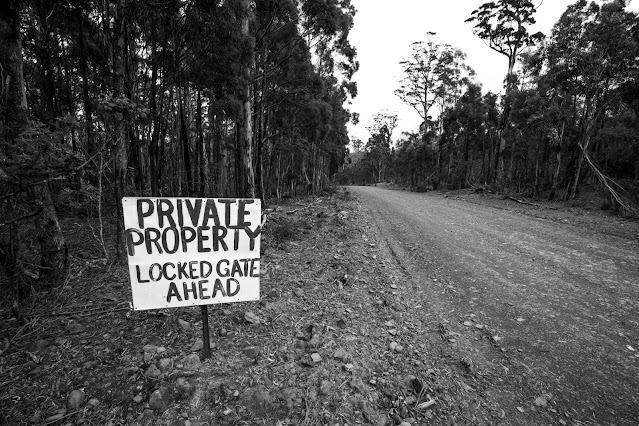Photography Book Review | Brian Rope
Title: Uninnocent Landscapes
Author: Ian Terry
Publisher: OUTSIDE THE BOX / Earth
Arts Rights
ISBN:
978-0-646-88105-8
Just two days before I began writing, this beautifully designed and printed book, Uninnocent Landscapes, was launched at the Sidespace Gallery in Hobart during the opening of Ian Terry’s exhibition of images from the book. Those who pre-ordered copies were fortunate enough to receive them in the post a couple of days earlier.
Terry tells us the book is the result of two years spent combining landscape photography and historical enquiry, seeking answers to questions. What could the landscape tell him about invasion, colonisation and the destruction of First People’s life and culture? What could it tell him about his own life on the island of lutruwita. He acknowledges that his project didn’t fully answer his questions, despite giving him a deeper knowledge of the landscape’s underlying stories. He intends his book to start conversations and, for that reason, commissioned other essays published within it.
The book is described as a photographic conversation. The foreword, by Tasmanian art historian Greg Lehman (descended from the Trawulwuy people), tells us it is “a 21st-century response to a journey undertaken by one of the first Europeans to recognise the humanity of the palawa nations.” That journey was George Augustus Robinson’s Big River Mission undertaken in 1831. So, whilst it certainly is a photographic conversation and contains over 50 sharply observed and carefully crafted black and white tritone images, the book is much more than that. It is telling a most important story. And all proceeds, from the book and accompanying exhibition, will be donated to the Giving Land Back Program of the Aboriginal Land Council of Tasmania - see https://www.givinglandback.org/.
 |
| Locked gate ahead © Ian Terry |
Terry’s excellent photographs are accompanied by words from Robinson’s journals describing the locations and what he had observed at those places whilst on his Mission. The captions with the photos reproduced here are very much abbreviated selections (by Terry) from the original words. Here is one example of the journal words relevant to the following image.
24 October 1831
This morning proposed to the chief Mannalargenna [Manalakina] to leave some of the dogs behind as they made too much noise. To this he appeared averse, and I observed that I had better tell the Governor that we was not looking for natives but after kangaroo. He replied that I should tell the Governor I was stopping in the sun. He is a shrewd man … Came to some large lagoons and encamped for the night … The country round these lagoons is a place of great resort for the natives. There are abundance of eels in these lagoons, so the natives inform me.”
 |
| A place of great resort © Ian Terry |
Robinson is a controversial figure in colonial history. He was given a remit by Lieutenant-Governor Arthur to protect and “civilise” the Nunani people living on lunawuni and teach them Christian values. The Big River Mission is often recognised as ending lutruwita First People’s resistance to invasion of their land. Terry’s introductory essay in the book provides considerable information about this part of our unfortunate history. It also explains how the landscapes of lutruwita are, for him, a place of enormous solace.
 |
| Melancholy © Ian Terry |
 |
| Clear of wood © Ian Terry |
The book also includes text contributions by Rebecca Digney (a proud pakana woman), Nunami Sculthorpe-Green (a proud palawa and Warlpiri woman) and Roderic O’Connor (a sixth-generation farmer committed to a sustainable farming future and returning part of his land to its pre-colonial state). Terry’s photographs helped Digney contextualise Robinson’s recorded events as real, inflicted on real people in real places. They caused Sculthorpe-Green to feel the loss of the landscape. O’Connor acknowledges that he still has much to learn.
Terry himself grew up in Queensland and Sydney. He relocated to lutruwita in 1984, immediately feeling at home on what most of us would agree is a “beautiful island”. He has worked as a national park ranger, freelance historian and heritage consultant. Most recently he has been curator of history at the Tasmanian Museum and Art Gallery.
So, this well-informed book tells a most important story and, in doing so, provides readers with considerable amounts of quality written and photographic material to assist educate us - even those previously lacking knowledge of any or all of the multiple matters covered.
 |
| Indignation © Ian Terry |
 |
| milaythina © Ian Terry |
There are numerous footnotes throughout the book telling us the meanings of Aboriginal words such as palawa. They have been used out of respect. I have also used the same words here for the same reason. I encourage you to purchase and read the book to learn the meanings (and much more) – and to support the cause its proceeds benefit. Move quickly as it is a short-run, boutique publication expected to sell out.
This
is a quality book, an important book, one which First Peoples and every other
Australian would benefit from reading.
This review is also available on the author's blog here.
